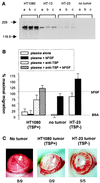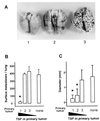A human fibrosarcoma inhibits systemic angiogenesis and the growth of experimental metastases via thrombospondin-1
- PMID: 9600967
- PMCID: PMC27689
- DOI: 10.1073/pnas.95.11.6343
A human fibrosarcoma inhibits systemic angiogenesis and the growth of experimental metastases via thrombospondin-1
Abstract
Concomitant tumor resistance refers to the ability of some large primary tumors to hold smaller tumors in check, preventing their progressive growth. Here, we demonstrate this phenomenon with a human tumor growing in a nude mouse and show that it is caused by secretion by the tumor of the inhibitor of angiogenesis, thrombospondin-1. When growing subcutaneously, the human fibrosarcoma line HT1080 induced concomitant tumor resistance, preventing the growth of experimental B16/F10 melanoma metastases in the lung. Resistance was due to the production by the tumor cells themselves of high levels of thrombospondin-1, which was present at inhibitory levels in the plasma of tumor-bearing animals who become unable to mount an angiogenic response in their corneas. Animals carrying tumors formed by antisense-derived subclones of HT1080 that secreted low or no thrombospondin had weak or no ability to control the growth of lung metastases. Although purified human platelet thrombospondin-1 had no effect on the growth of melanoma cells in vitro, when injected into mice it was able to halt the growth of their experimental metastases, providing clear evidence of the efficacy of thrombospondin-1 as an anti-tumor agent.
Figures



Similar articles
-
SiRNA-mediated inhibition of vascular endothelial growth factor severely limits tumor resistance to antiangiogenic thrombospondin-1 and slows tumor vascularization and growth.Cancer Res. 2003 Jul 15;63(14):3919-22. Cancer Res. 2003. PMID: 12873985
-
Thrombospondin-1-mediated metastasis suppression by the primary tumor in human melanoma xenografts.J Invest Dermatol. 2001 Nov;117(5):1042-9. doi: 10.1046/j.0022-202x.2001.01552.x. J Invest Dermatol. 2001. PMID: 11710911
-
In vivo mechanisms by which tumors producing thrombospondin 1 bypass its inhibitory effects.Genes Dev. 2001 Jun 1;15(11):1373-82. doi: 10.1101/gad.193501. Genes Dev. 2001. PMID: 11390357 Free PMC article.
-
Endogenous regulators of angiogenesis--emphasis on proteins with thrombospondin--type I motifs.Cancer Metastasis Rev. 2000;19(1-2):159-65. doi: 10.1023/a:1026570331022. Cancer Metastasis Rev. 2000. PMID: 11191055 Review.
-
Mechanisms of thrombospondin-1-mediated metastasis and angiogenesis.Semin Thromb Hemost. 2004 Feb;30(1):127-36. doi: 10.1055/s-2004-822977. Semin Thromb Hemost. 2004. PMID: 15034804 Review.
Cited by
-
Thrombospondin-1 inhibits endothelial cell responses to nitric oxide in a cGMP-dependent manner.Proc Natl Acad Sci U S A. 2005 Sep 13;102(37):13141-6. doi: 10.1073/pnas.0502977102. Epub 2005 Sep 6. Proc Natl Acad Sci U S A. 2005. PMID: 16150726 Free PMC article.
-
Collaboration between hepatic and intratumoral prodrug activation in a P450 prodrug-activation gene therapy model for cancer treatment.Mol Cancer Ther. 2007 Nov;6(11):2879-90. doi: 10.1158/1535-7163.MCT-07-0297. Epub 2007 Nov 7. Mol Cancer Ther. 2007. PMID: 17989319 Free PMC article.
-
NF-kappaB balances vascular regression and angiogenesis via chromatin remodeling and NFAT displacement.Blood. 2010 Jul 22;116(3):475-84. doi: 10.1182/blood-2009-07-232132. Epub 2010 Mar 4. Blood. 2010. PMID: 20203265 Free PMC article.
-
Immunogene therapy of tumors with vaccine based on Xenopus homologous vascular endothelial growth factor as a model antigen.Proc Natl Acad Sci U S A. 2001 Sep 25;98(20):11545-50. doi: 10.1073/pnas.191112198. Epub 2001 Sep 11. Proc Natl Acad Sci U S A. 2001. PMID: 11553767 Free PMC article.
-
Regulation of nitric oxide signalling by thrombospondin 1: implications for anti-angiogenic therapies.Nat Rev Cancer. 2009 Mar;9(3):182-94. doi: 10.1038/nrc2561. Epub 2009 Feb 5. Nat Rev Cancer. 2009. PMID: 19194382 Free PMC article. Review.
References
-
- Prehn R T. Cancer Res. 1991;51:2–4. - PubMed
-
- Prehn R T. Cancer Res. 1993;53:3266–3269. - PubMed
-
- O’Reilly M S, Holmgren L, Shing Y, Chen C, Rosenthal R A, Moses M, Lane W S, Cao Y, Sage E H, Folkman J. Cell. 1994;79:315–328. - PubMed
-
- Holmgren L, O’Reilly M S, Folkman J. Nat Med. 1995;1:149–153. - PubMed
-
- Chen C, Parangi S, Tolentino M J, Folkman J. Cancer Res. 1995;55:4230–4233. - PubMed
Publication types
MeSH terms
Substances
Grants and funding
LinkOut - more resources
Full Text Sources
Other Literature Sources
Miscellaneous

